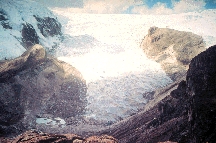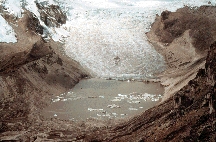"Since 1963, the Qori Kalis glacier in Peru's Quelccaya ice cap
in the Southern Andes has shrunk by at least 20%.
The rate of retreat has been 509 feet per year, or 1.3 feet per day!
You can literally sit there and watch it retreat.
And if you assume that the current rate of retreat will continue,
this ice cap will disappear some time between 2010 and 2020."
- Lonnie Thompson, Ph.D., Glacial Geologist, Ohio State University -


March 4, 2001 Columbus, Ohio - At the American Association for the Advancement of Science (AAAS) meeting in San Francisco on February 25, Prof. Lonnie Thompson from Ohio State University's Department of Geological Sciences presented a paper entitled "Disappearing Glaciers - Evidence of A Rapidly Changing Earth." He spoke before a special session of Earth Systems Science: The Quiet Revolution, organized by the International Geosphere/Biosphere program. Dr. Thompson has completed 37 expeditions since 1978 to collect and study perhaps the world's largest archive of glacial ice cored from the Himalayas, Mount Kilimanjaro in Africa, the Andes in South America, the Antarctic and Greenland.
Click here to subscribe and get instant access to read this report.
Click here to check your existing subscription status.
Existing members, login below:
© 1998 - 2024 by Linda Moulton Howe.
All Rights Reserved.

